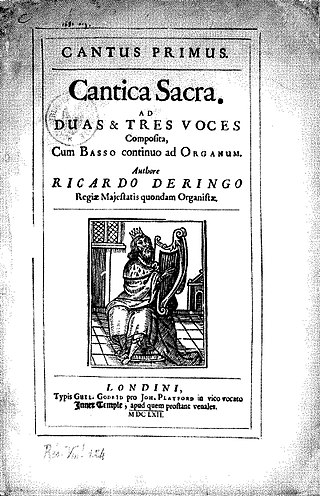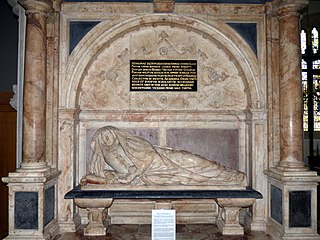Publications
- Stainer & Bell, "Henry Youll: Canzonets to Three Voices" (1608), (Ref. EM28)
- Stainer & Bell, "Henry Youll: In the Merry Month of May" (1608)
- "Henry Youll: While Joyful Springtime Lasteth" (Published by Hal Leonard, HL.08551265))
- "Three English Madrigals. Pity me my own sweet Jewel. Fly not so fast. Messalina's Monkey", Roberton Publications (1977), ASIN: B0000D37SB
- "Pipe, Shepherds, Pipe" (Scott), ASIN: B0000D5FTH
Related Research Articles

Sir John Stainer was an English composer and organist whose music, though seldom performed today, was very popular during his lifetime. His work as choir trainer and organist set standards for Anglican church music that are still influential. He was also active as an academic, becoming Heather Professor of Music at Oxford.
John Coprario, also known as Giovanni Coprario or Coperario, was an English composer and viol player.

Thomas Morley was an English composer, theorist, singer and organist of the Renaissance. He was one of the foremost members of the English Madrigal School. Referring to the strong Italian influence on the English madrigal, The New Grove Dictionary of Music and Musicians states that Morley was "chiefly responsible for grafting the Italian shoot on to the native stock and initiating the curiously brief but brilliant flowering of the madrigal that constitutes one of the most colourful episodes in the history of English music."
Thomas Weelkes was an English composer and organist. He became organist of Winchester College in 1598, moving to Chichester Cathedral. His works are chiefly vocal, and include madrigals, anthems and services.
In music, a canzonetta is a popular Italian secular vocal composition that originated around 1560. Earlier versions were somewhat like a madrigal but lighter in style—but by the 18th century, especially as it moved outside of Italy, the term came to mean a song for voice and accompaniment, usually in a light secular style.
Robert Jones was an English lutenist and composer, the most prolific of the English lute song composers.
Giles Farnaby was an English composer and virginalist whose music spans the transition from the Renaissance to the Baroque period.
John Ward (1590–1638) was an English composer. He trained as a singer in Canterbury, where he was a chorister at Canterbury Cathedral. He then moved to London where he produced religious and secular works, and he also appears to have maintained a residence in Essex. Ward's compositions, some of which were published in his lifetime, consist of madrigals, works for viol consort and Anglican church music. His madrigals are remarkable for their fine texts, broad melodic lines and originality.
John Bennet was a composer of the English madrigal school. Little is known for certain of Bennet's life, but his first collection of madrigals was published in 1599.

Richard Dering — also Deering, Dearing, Diringus, etc. — was an English Renaissance composer during the era of late Tudor music. He is noted for his pioneering use of compositional techniques which anticipated the advent of Baroque music in England. Some of his surviving choral works are part of the repertoire of Anglican church music today.
"Now is the month of maying" is one of the most famous of the English balletts. It was written by Thomas Morley and published in 1595. It is based on the canzonet So ben mi ch'a bon tempo used by Orazio Vecchi in his 1590 Selva di varia ricreatione. It was printed in Thomas Morley's First Book of Ballets to Five Voyces (1595).
Michael East was an English organist and composer. He was a nephew of London music publisher Thomas East, although it was once thought that he was his son.
Thomas Greaves was an English composer and lutenist.
Thomas East was an English printer who specialised in music. He has been described as a publisher, but that claim is debatable. He nevertheless made an important contribution to musical life in England. He printed the significant madrigal collection, Musica Transalpina, which appeared in 1588.

Elizabeth Bacon was an English aristocrat. She is presumed to have been the Lady Neville of My Ladye Nevells Booke, an important manuscript of keyboard music by William Byrd, which was compiled in 1591. She was the daughter of Queen Elizabeth's Lord Keeper of the Great Seal, Sir Nicholas Bacon, by his first wife, Jane Ferneley. She was, successively, the wife of Sir Robert D'Oylie, the courtier Sir Henry Neville, and the judge Sir William Peryam.
Walter Porter (c.1587–1659) was an English composer and church musician. He travelled to Italy to study under Monteverdi, and shows Italian influence in madrigals and his one surviving anthem.
Jeremy or Jeremiah Savile was an English musician in London under the Commonwealth. He taught the voice and viol, and composed songs.
References
- Oxford Dictionary of National Biography , Oxford University Press, ISBN 0-19-861411-X, ISBN 978-0-19-861411-1. The first edition of this text is available at Wikisource: . Dictionary of National Biography . London: Smith, Elder & Co. 1885–1900.
- Here of a Sunday Morning, "The English Madrigal"